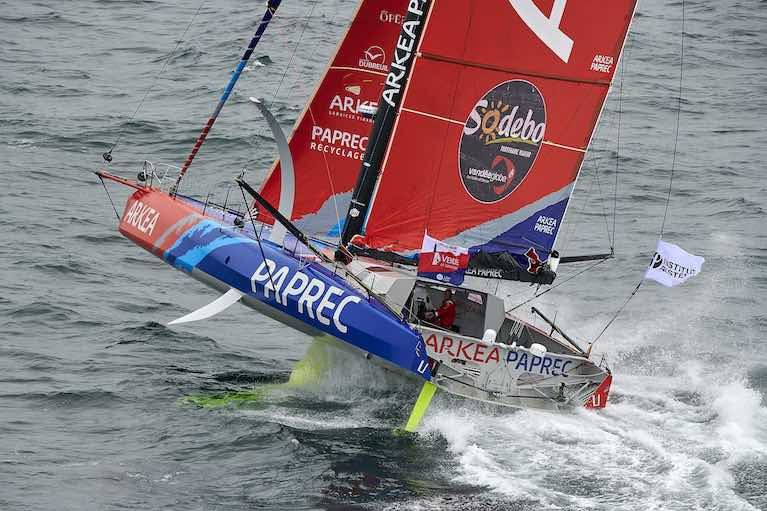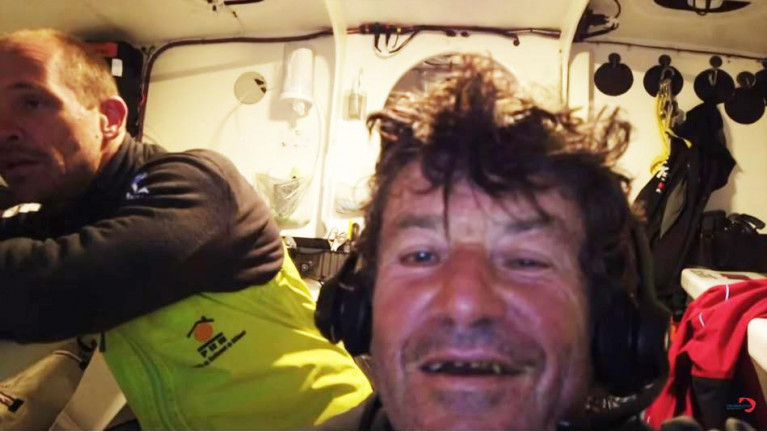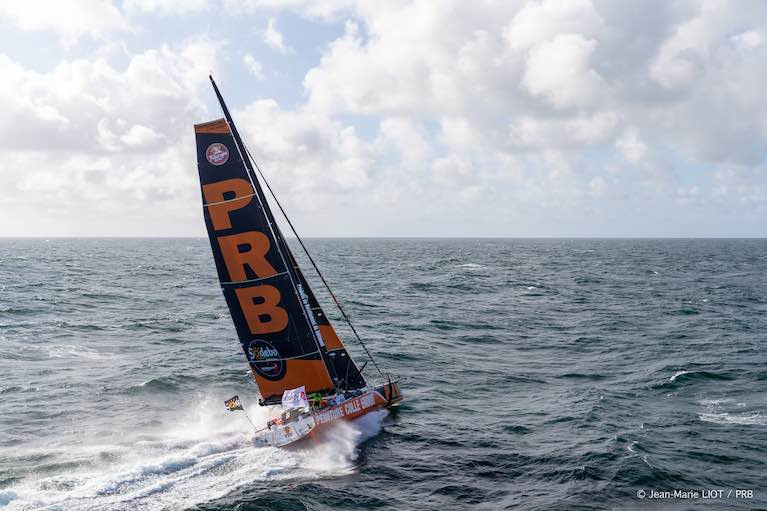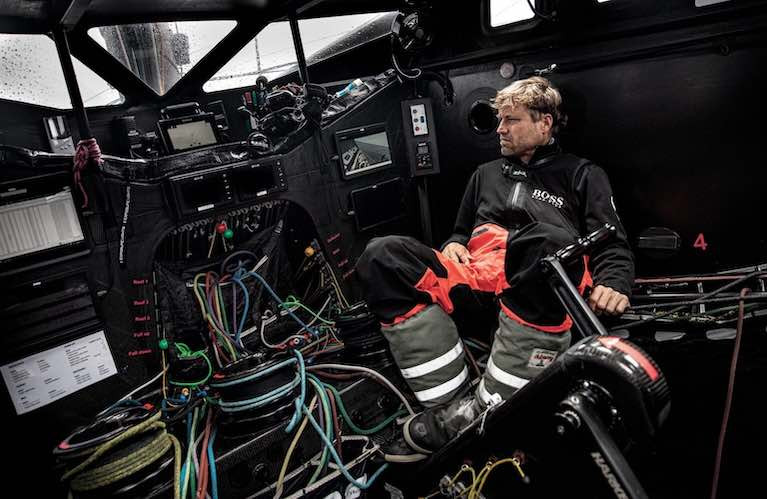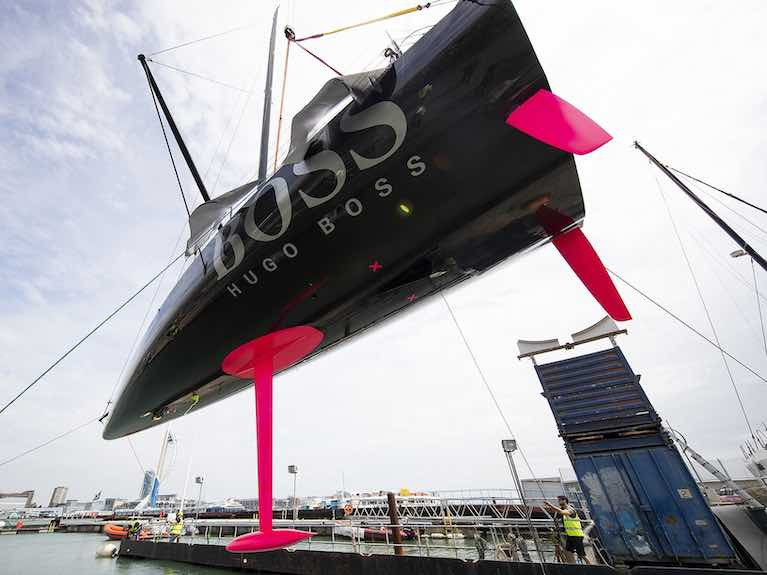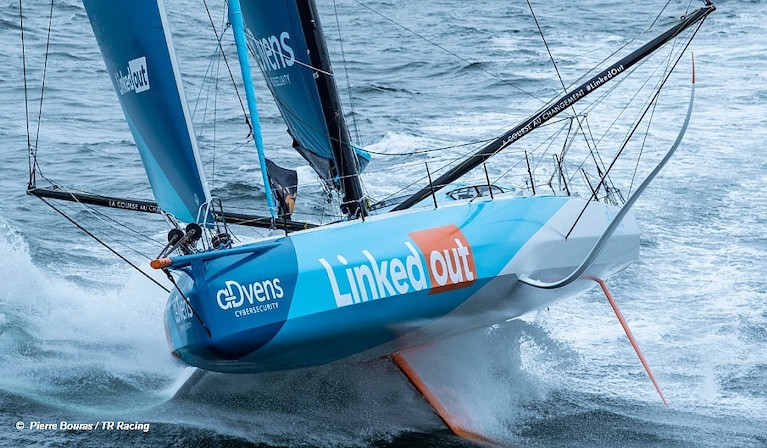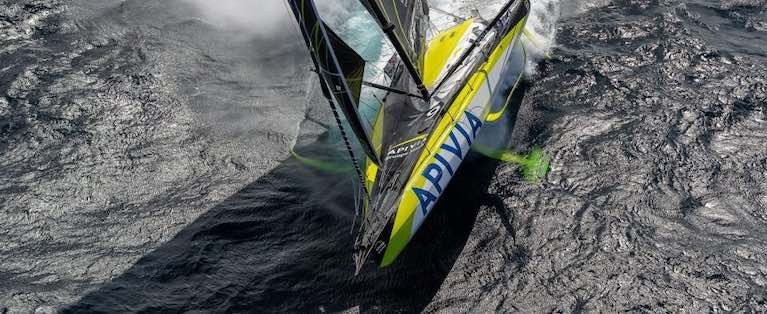Displaying items by tag: Vendee Globe
Nine IMOCAs Pass Cape of Good Hope in Same Day of Vendee Globe Race
Given that the Vendée Globe fleet started on Sunday 8th November in Les Sables d’Olonne with a record-sized fleet of 33 IMOCAs and there are still, technically, 31 tracked on the race course, it is not entirely unexpected to have no fewer than nine boats (and ten skippers) cross the longitude of the Cape of Good Hope today. But this is a unique, unprecedented statistic for a unique and ever more engaging edition of the solo non-stop round the world race.
Passing at 0230hrs UTC this Wednesday morning in fourth place was Sébastien Simon on ARKEA PAPREC. The 30-year-old Les Sablais skipper has been showing good speeds in recent days on the 2020 Juan K design. But no sooner was he into the Indian Ocean than he reported substantial damage to his starboard foil and its casing after hitting an object in the water at 0820hrs UTC this morning.
Water ingress
Simon slowed the boat which had some unspecified amount of water ingress, and had stabilised the situation, this afternoon making between eight and 12kts on port gybe racing towards the back of a low pressure system.
After ARKEA PAPREC crossed Good Hope the IMOCAs passed Good Hope like buses, Germany’s Boris Herrmann (Seaexplorer-Yacht Club de Monaco) at 1hr 4min after Simon, Jean Le Cam (Yes We Cam!) crossed 1hr 17 min after the German skipper, then Damien Seguin (Groupe Apicil) 42mins later, Yannick Bestaven (Maitre Coq IV) 3hrs 09mins after, Benjamin Dutreux (OMIA-Water Family) 1hr 50 mins later, Giancarlo Pedote (Prysmian Group) 2hrs 12 mins later, then came Sam Davies (Initiatives Coeur) 1hr 50m later. Isabelle Joschke (MACSF) crossed 1hr 4mins after Davies.
Confidence to attack
The proven reliability of the 2016-17 race winning boat, now Bureau Vallée 2, and the desire and confidence to attack hard seem to be the key to Louis Burton’s progress up the leaderboard. So far he has routed south, closer to the ice exclusion zone and so sailing less miles but always in stronger winds and bigger seas. The 35-year-old from Saint-Malo was seventh on the last edition of the race, blessed with a passage through the southern oceans mostly in relatively benevolent conditions thanks to a high-pressure system which he rode for weeks.
President of France
Rescued Kevin Escoffier and rescuer Jean Le Cam were called by Skype onboard Yes We Cam! by the President of France, Emmanuel Macron who congratulated Le Cam on his seamanship, saying,
“I was reassured by the news. I am a fan of Jean’s. So I wanted to say hats off to him. We are extremely proud of Kevin and you and for the whole ‘family’ and of what you did.” Said Macron
It is still planned to drop Kevin Escoffier on a French navy frigate the Nivose which could rendezvous with Yes We Cam near the Crozet or Kerguelens but this has not yet been confirmed by the authorities. If not it might be New Zealand before Escoffier could be taken off.
For all that the latest generation of high speed foiling IMOCAs are designed for top speeds of more than 30kts, now racing in the steep, short seas of the Indian Ocean, race leader Charlie Dalin has been through his biggest storm to date and today said he is having to learn how to slow his boat and manage it.
“ I am discovering something I have never had to do before.” said Dalin, “ I have to un-trim, detune my boat. I feel now 50% of the time I am trying to trim the sails and the foils and keel to go faster, and 50% of the time I am de-tuning the boat. I find myself looking for the brake pedal. The sea state in the Indian Ocean is really what is limiting my speed. Sometimes the boat accelerates in the surf and we go to 28-30kts and you don’t know how it is going to end. It is a really weird to way to think, ‘I have this wind strength, this wind angle is this and I have these sails up, and I have the foil set like this, but if I change all these settings I should slow the boat down, and slow the boat down.' I never had to do this before in my racing career.”
Lead of over 250 miles
With a lead of over 250 miles, Dalin admitted today he no longer routes his rivals, Burton tracking 165 nautical miles south of third-placed Ruyant, not because he doesn’t care but he considers it wasted energy when they are in different wind regimes, “ I have stopped routing them. Entirely. I have voluntarily stopped taking the GRIB files back to Thomas. I cannot do that. I don’t want to know what conditions he is going to have. There is not much point. We have different weather systems, we are a bit more than 12 hours apart, so there is not much point. I focus on my race, my course. And we will see how it turns out. I have given up. I don’t find it useful to do this.”
Relieved Escoffier Speaks About His Vendee Globe Rescue By Jean Le Cam
After being rescued from his liferaft by fellow Vendée Globe competitor Jean Le Cam in big seas and strong winds the early hours of this morning some 840 nautical miles South West of Cape Town, South Africa, Kevin Escoffier has been recovering on board Le Cam’s appropriately named IMOCA 60 Yes We Cam!
The 40-year-old solo sailor, a member of a well known Saint Malo sailing family, had to abandon his IMOCA 60 PRB, within what he later estimated to be two minutes when his boat virtually broke in two after burying its nose in a wave while racing in five metre waves and 25 knot South Westerly winds. Escoffier only had time to grab his survival suit before being washed off the boat and clambering into his liferaft which automatically inflated.
Veteran 61-year-old Jean Le Cam, racing on his fifth Vendée Globe, answered the request of Race Direction to divert to try and pick up Escoffier whose boat’s emergency beacon had been activated at 1346hrs UTC.
When he arrived in the area some two hours later he located Escoffier in his liferaft but was then unable to manoeuvre and prepare properly to effect a rescue on time before losing sight of the liferaft in the big seas, strong winds and growing darkness.
Race Direction in Les Sables d’Olonne diverted three other skippers, Germany’s Boris Herrmann (Seaexplorer-Yacht Club de Monaco), Yannick Bestaven (Maître CoQ IV) and Sébastien Simon (ARKEA PAPREC) and drew up a search protocol using Meteo France’s MOTHY ( (Modèle Océanique de Transport d'HYdrocarbures) drift prediction programme and engaged the three solo skippers in a triangle search pattern. They had intermittent distress beacon signals which appeared to follow no pattern.
But it was only when he was directed close to a locator beacon position which coordinated with the predicted drift pattern that Le Cam spotted a reflected beam of light bouncing off a wave that he realised he had finally located Escoffier again. He plucked him from the liferaft at 0118hrs UTC this morning.
It was only when the two suddenly appeared together on a Skype video call which had been running constantly from Le Cam’s boat to a monitor in the Les Sables d’Olonne HQ that Race Direction suddenly realised the mission had been successful and Escoffier had been rescued.
A world renowned ocean racer may have been on only his second ever solo IMOCA race but Escoffier has won the crewed Volvo Ocean Race in 2018 on the Dongfeng team and was part of a successful Trophée Jules Verne round the world in 2012. He was key technical director of Armel Le Cléac’h Vendée Globe winning programme on the 2016-17 race.
Smiling and relieved as he spoke to the Vendée Globe English Live from on board Le Cam’s Yes We Cam he said:
“I’m doing pretty well, pretty well, much better than last night. Which I spent in a very bad bed and breakfast (laughing). It’s still hard for me to believe it, to believe that I broke the boat inside the wave at 90 degrees. I should have taken a picture for people to believe me. Just after the wave, the bow was pointing at 90 degrees from the stern of the boat, and all the water was coming forward. The water level inside rose very fast and I had a very short time to decide what to do.
“After, well then I’ve been thinking about getting on the life-raft and if I should have waited. But it’s done, it’s done. Should I have been trying to stay a bit longer on the boat? It might have been better for people to find me but I’m pretty sure I wouldn’t have been able to stay the night on the boat. Because the water that was already above the deck level it was too dangerous. I was better in the life raft.”
“It’s unbelievable what happened. The boat folded up on a wave at 27 knots. I heard a bang, but to be honest, I didn’t need to hear that to know what had happened. I looked at the bow. It was at 90°. In a few seconds, there was water everywhere. The stern was under water and the bow was pointing up to the sky. The boat split in half in front of the mast bulkhead. It was as if she folded up. I promise. I’m not exaggerating. There was an angle of 90° between the stern and the bow.
“I didn’t have time to do anything. I just had time to send a message to my team. I’m sinking I’m not joking. MAYDAY. Between the moment when I was out on deck trimming the sails and when I found myself in my survival suit, barely two minutes had passed. It all happened extremely quickly.”
“I came out of the boat and put on my survival suit. I could see smoke. The electronics were burning. Everything went off. My only reflex was to grab my telephone to send the message and pick up the survival suit which I never stow away. I wanted to pick up the grab bag, but I couldn’t get to it with the water rising. I grabbed the liferaft at the stern. I couldn’t get into it as it was three metres under the water. The water was up to the door in the cockpit.”
He continued, “For me I was going to stay the whole night in the life raft, that was what I was thinking, it was okay for me, it was safer to switch from one to the other with less winds and less waves. I spent the night quite well, I mean I wasn’t comfortable, but in my head it was better, I was sure that the day after someone would be coming with less winds and less waves, and then I’d be able to get from the life raft to the boat. I had a bit of trouble sleeping during the night, I had been eating a bit and drinking the water I had on board. Close to the morning I heard a sail flapping so I got out, had my head out of the life raft and I saw it wasn’t dark anymore because of the moon, even with no sun we were able to see very well and I saw Jean just above me, at 100/200 metres from me, I asked him ‘Now, we’re doing it now?” and he said ‘Yes yes let’s do it now’ and he told me ‘I will come against you’ he wanted to have his boat parallel to the life raft but he was a bit too fast and it was 5 metres away, I don’t know exactly, where he threw me a line with a buoy at the end which I caught. And both of us pulled it to get the life raft as close as possible to his boat, and when I was close enough I jumped and caught the back of the boat.
“He said ‘Are you on board, are you on board Kevin??!’ he was very happy.
I said, ‘Yes I am on, I’m sorry to disturb your race, Jean.’ We had a big hug."
Race direction have discussed a plan to evacuate Escoffier on to the French Navy’s Nivôse a Floréal-class frigate at the Kerguelen Islands but this has yet to be confirmed by the authorities.
Meanwhile, the International Jury will convene in the next few days to discuss time compensations for the skippers whose races were put in parenthesis while they were engaged in the rescue mission. This process takes into account not only the actual time lost when the sailors were away from their race route, but also any significant changes in their racing conditions – wind and routing- caused by the delay.
Charlie Dalin continues to lead the race by 218 miles from Thomas Ruyant (LinkedOut) who crossed the longitude of the Cape of Good Hope at 1341hrs UTC. He was 14 hours and 30 minutes after Dalin’s passage last night. Louis Burton – who is Escoffier’s cousin by marriage – now lies third on Bureau Vallée 2.
"He's on board with Jean!" Vendee Globe Solo Sailor Escoffier Rescued By Fellow Competitor
A successful rescue operation has been carried out between some of the leading boats in the Vendee Globe race with the retrieval of skipper Kevin Escoffier (PRB) from his liferaft by Jean Le Cam (Yes We Cam!).
At 0118hrs UTC the PRB Team was informed that Escoffier has been rescued by fellow competitor Le Cam.
As Afloat reported previously, Escoffier had to abandon his IMOCA 60 PRB following damage yesterday afternoon around 1346hrs UTC and took to his liferaft some 840 nautical miles SW of Cape Town.
The rescue mission was coordinated from Les Sables d’Olonne by Vendée Globe Race Direction in collaboration with CROSS Griz Nez and MRCC South Africa. The President of PRB, Jean-Jacques Laurent was at the Race HQ with race director Jacques Caraës and the race direction team assisting through the entire process.
"He's on board with Jean!" These short words came as a huge relief for the whole team, for Escoffier’s family and all those involved in and following the Vendée Globe
Kevin has so far only been seen aboard YesWeCam via live video as Jean Le Cam had his video system connected during all the search operations. No one has yet been able to talk with the PRB skipper who just appeared smiling, bundled up in his survival suit alongside Jean Le Cam.
Vendée Globe race director Jacques Caraës outlined, “We sent Jean back to a position received by the CROSS Gris Nez, the position sent by the onboard EPIRB distress beacon. Météo France's drift simulation also delivered a trace. Jean set off at 00h15 UT (1h15 French time) on our request to reach this point at reduced speed. He found no one at the given location. He then resumed its journey southeast for three quarters for between 45 minutes and an hour - an hour. As he was making headway at 1.5 knots in a 20-25 knot wind under very reduced sail (3 reefs in the mainsail and no engine), he disappeared from the screen when suddenly we heard him talk. We no longer saw anyone. Then, a few minutes after 1:06 UT or 2:06 French time (time at which he had precisely to retrieve Kevin on board), Jean went back down to the chart table and then we saw Kevin arrive behind his back in a survival suit. They both appeared fit seconds before the video cut. He is fine. Everyone is well. They are recovering!"
On January 6, 2009, during the 2008-2009 Vendée Globe, Vincent Riou, the then the skipper of PRB, rescued Jean Le Cam from his upturned IMOCA 60 which capsized at Cape Horn.
This time 61-year-old five times Vendée Globe racer Le Cam has reversed the roles delivering Escoffier, the 40-year-old skipper from Saint Malo, from a potentially lethal situation.
The whole TEAM PRB and the Vendée Globe community sincerely thanks Jean Le Cam and the three other skippers, Boris Hermann, Yannick Bestaven and Sébastien Simon who have worked heroically and tirelessly to find Kevin, as well as the race director, the CROSS Gris Nez. and the MRCC Cape Town which coordinated the search
Vendee Globe Drama: Le Cam Alters Course To Rescue Kevin Escoffier (PRB) After Distress Beacon Activated
Jean Le Cam, the nearest competitor to stricken Vendee Globe skipper Kevin Escoffier, has seen Escoffier in his life raft and, according to unconfirmed reports on social media, Le Cam is going to start his engine in order to rescue his rival.
Escoffier, 40, who is racing in third place in the Vendée Globe solo non-stop around the world race, positioned some 550 nautical miles SW of Cape Town, triggered his distress beacon this afternoon. He was racing in a strong SW’ly air stream on starboard tack behind a weather front.
 Kevin Escoffier on board PRB Photo: via Facebook
Kevin Escoffier on board PRB Photo: via Facebook
At 1346hrs (UTC), Escoffier managed to send a message to his shore team, explaining that he had an ingress of water into his boat. The rescue authorities (MRCC Cape Town and CROSS Griz Nez) are preparing an action plan in collaboration with his PRB shore team, with Jacques Caraës and the Vendée Globe Race Direction team. Jean Le Cam, the nearest competitor, changed course to sail to the last position given by the boat when the beacon was triggered (40°55 S 9°18 E).
 Vendee Globe rivals converge on Kevin Escoffier's stricken PRB after a distress alert was sounded by the third-placed skipper
Vendee Globe rivals converge on Kevin Escoffier's stricken PRB after a distress alert was sounded by the third-placed skipper
Hugo Boss & Alex Thomson Out of Vendee Globe Race
Alex Thomson, the pre-race favourite to win the Vendee Globe, is out of the non-stop round the world race this afternoon after suffering rudder damage in the Southern Atlantic.
The British sailor is heading for Cape Town after a week of setbacks on his boat Hugo Boss.
The incident occurred on what was Thomson’s 19th day of racing, and it followed significant effort over the last five days and nights repairing cracks to the internal bow structure of his boat. Thomson was getting into his stride at the gateway to the Roaring Forties where his latest generation IMOCA was designed to be at its best.
Alex is currently 1,800 nautical miles from Cape Town and it is expected to take him around seven days to make the journey.
The British skipper, who was racing in the Vendée Globe for the fifth time, had received huge support and respect from around the world for the efforts he made to repair the bow area but there was no way to safely fix the rudder damage to allow him to race on for the what would have been the best part of one month in the hostile Southern Ocean.
Alex Thomson said, “Unfortunately, a repair is not possible. We therefore accept that this will be the end of the race for us. Myself, my team and our partners are of course deeply disappointed. We believe the best was yet to come in this race”
One of the two outstanding favourites to win this Vendée Globe, Thomson was third on the 2012-13 edition and finished second in 2016-17 after fighting back from being 48 hours behind eventual winner Armel Le Cléac’h at Cape Horn to finish only 16 hours behind the French skipper.
Luck has rarely run in his favour on this non-stop solo round the world race. In 2004-5 on his first attempt he had to abandon into Cape Town with damage to his deck after his boom gooseneck failed and in 2008-9 he had to retire early in the race with structural problems caused by a huge gale on the Bay of Biscay.
A statement from Alex and the team:
*******************
After incurring damage to the starboard rudder of the boat, Alex has ceased racing in the Vendée Globe and is now sailing the boat towards Cape Town.
Alex last night disconnected the starboard rudder and has since been sailing the yacht with just one rudder. After assessing the situation today, Alex and the team have decided that the only course of action is to cease racing and sail the boat to Cape Town.
Alex said: “Unfortunately, a repair is not possible. We, therefore, accept that this will be the end of the race for us. Myself, my team and our partners are of course deeply disappointed. We believe the best was yet to come in this race”.
Alex is currently 1,800 nautical miles from Cape Town and it is expected to take him around seven days to make the journey. He’ll do so without the use of his starboard rudder and so will proceed safely and cautiously.
Our technical team will travel to Cape Town to meet the yacht upon arrival.
On behalf of Alex and the team, we thank you for your support during this time.
Alex Thomson Reports Rudder Damage to Hugo Boss in Vendee Globe
Vendee Globe competitor Alex Thomson Racing has issued an alert describing rudder damage to Hugo Boss which is reported to have occurred around 1900hrs UTC this Friday evening.
Thomson has control of the yacht with one rudder, and is safe and in no danger onboard.
Thomson is racing in 12th position and was doing around 10kts in an easterly direction on the 21hrs TU position report.
Race tracker observers had noticed he was quite slow last night. Now he is averaging 10 knots when all those around him are averaging 17 knots. It is likely his starboard rudder is disconnected as they are all on port gybe at the moment and that would mean his port rudder would be out of the water if he allowed the boat to fully heel.
A team statement reads as follows: at approximately 19:00 UTC this evening Alex Thomson notified his technical team onshore of damage to the starboard rudder of his HUGO BOSS boat. The team immediately advised Thomson to disconnect the rudder to regain steerage. He now has control of HUGO BOSS with one rudder and is safe and in no danger onboard. The team is working to assess the extent of the damage. A further update will be released on Saturday 28th November.
It is yet another set-back for the British skipper the round the world race. The last four days were spent making repairs to the bow after a structural failure cost Hugo Boss the race lead.
Thomas Ruyant Cuts Foil & is Back in Vendee Globe Race Mode
After cutting off part of his damaged port foil LinkedOut solo skipper Thomas Ruyant is back in full race mode, chasing runaway Vendée Globe leader Charlie Dalin who has escaped into the Roaring Forties, surging eastwards towards the longitude of Cape of Good Hope now with a cushion of 300 miles.
Ruyant cut two metres from the tip of his damaged foil in a perilous operation which was made easier by the unusually clement wind and sea conditions in the South Atlantic. His speeds will be compromised on starboard gybe especially during the ensuing month in the southern oceans but the skipper from north of France is determined to all he can to mitigate any loss of performance.
“Thomas is moving well now and wants to get as far south, to cross the fleet before he gybes over and it is good to see him back in the race at almost full potential. In terms of numbers it is difficult to estimate how much his potential will be compromised, the designers and team are working on estimations to what the new polars would be but the boat is compromised we don’t have the righting moment that we used to, but whether that is ten percent or twenty per cent we don’t know yet. It might be two or three or four knots when the boat is being used at full potential.” Team Manager Marcus Hutchinson suggested on the Vendée Globe Live programme at lunch time today.
With more than 300 miles of a lead Charlie Dalin will be able to modulate his speed in the south on the Verdier designed Apivia. He was averaging more than 20kts at times today, now racing at around 41 degrees south, he gybed at around 0800hrs this Friday morning at around 50 nautical miles north of the Antarctic Exclusion Zone – the virtual ice barrier that the solo racers must stay north of. With around 1300 miles to go to the longitude of the Cape of Good Hope, Dalin should cross on Monday morning.
Finally clear of the sticky clutches of the South Atlantic high pressure the main peloton seem to have been gifted a great weather situation, not least Louis Burton (Bureau Vallée) and Sam Davies (Initiatives Coeur) who were first to break south three days ago. They are lined up on the face of a low pressure system which should catapult them east to close with slightly more wind pressure than their closest rivals to their north. But there is the enduring prospect of a fast, close race between the boats placed second to tenth today.
Yannick Bestaven is fourth this afternoon on Maitre Côq, 14 miles up on Kevin Escoffier (PRB) who in turn is 14 miles ahead of Boris Herrmann (Seaexplorer-Yacht Club de Monaco) 18 miles clear of ARKEA PAPREC sailed by Sébastien Simon. Further to the south Burton and Davies are 12 and 50 miles behind Simon.
Burton continues to impress. The skipper from Saint Malo is on his third Vendée Globe. His boat won the race in 2016-17 in the hands of Armel Le Cléac’h and Burton’s team had already organised its purchase before it had crossed the finish line last January. He trains independently of the IMOCA training groups at Port La Fôret and Lorient and works to a limited budget, such that the VLP-Verdier design is in the same configuration as when Le Cléac’h triumphed four years ago.
In his wake, Sam Davies is getting ready for a change in her conditions aboard: “We’re off now on the conveyor belt. I have been telling myself that this may be the last time we see blue skies for a while, as they are not very common in the Southern Ocean. The solar panels are being fully charged. I’m spending a lot of time outside to stock up with vitamin D before the South.”
There was a similar atmosphere with Kevin Escoffier (PRB), 5th in the fleet on a slightly more northerly route: “The world will be changing for us tomorrow. We’ll be sailing ahead of the front. We’re going to have to be fast to stick with it for as long as possible. You have to know exactly when to gybe in relation to the front to get in the right place for the low-pressure system forecast for 1st December. It will be slamming a bit more with winds forecast in excess of forty knots and heavy seas according to the charts. I cleaned up the boat to get ready for this ‘New World’ ahead of us in the Forties and the Indian Ocean. My next shower will probably involve using the kettle.”
Meanwhile Alex Thomson took the chance last night to further consolidate his repairs on HUGO BOSS before he heads into the big south. But this morning he had the black and pink machine hammer down averaging over 20kts. He is 11th, 661 miles behind Dalin this afternoon. Front of mind will be memories of 2016-17 when he was 819 nautical miles behind Armel Le Cléac’h at Cape Horn but closed that gap to finish 16 hours behind in second place.
“It feels good to be focusing back on the race again and chasing the leaders into the Southern Ocean” Thomson said. “There is a long way to go but I’m feeling good and looking forward to heading downwind finally where I think we’ll really see what HUGO BOSS is capable of”.
Vendee Globe Racers Have Full Southern Ocean Regime On The Menu
At the same time as Alex Thomson euphorically announced this morning that ‘the BOSS is Back’ in the Vendee Globe Race after the British skipper completed four days and nights of structural repairs to the inside of the bow of HUGO BOSS, his French rival, second-placed Thomas Ruyant and his team are deciding what to do about the damaged port foil on his LinkedOut. Despite their respective challenges to win the Vendée Globe being compromised for the moment, both skippers remain highly motivated.
The danger in leaving the damaged foil as it is, is that it may break off and cause collateral damage to the hull of his IMOCA or indeed the outrigger support rods. Laurent Bourguès, technical director of Ruyant’s TR Racing has assembled a Task Force group comprising the designers, engineers and builders who collaborated in the production of LinkedOut’s V2 second-generation foil. So designer Guillaume Verdier is working with Antoine Koch the foil specialist, François Pernelle, who is head of the TR Racing design office, and marine design engineer Hervé Penfornis. This brains trust are in charge of the next steps for skipper Thomas Ruyant who is 120 miles behind the leader and still in the throes of escaping from the light winds of the South Atlantic high.
“First we need to evaluate accurately the structure of the damaged foil," explains Laurent Bourguès. "Guillaume Verdier performs all the calculations to assess the level of stress safe for a foil of which the shaft structure is compromised. And therefore, in the next few hours we need to work out the acceptable level of risk to hold to a foil which is now unusable. Thomas has withdrawn it as much as it comes in but at certain angles of heel, reaching on starboard tack, part of the foil is dragging in the water and so is subject to considerable stress, especially at high speed. In the event of it breaking we then worry about collateral damage at the level of the outrigger tie rod. If this risk seems too great to us, Thomas will have to cut the foil. He has all the tools to do so. It is up to us, to recommend where to cut it either in its widest part, flush with the hull, or nearer the tip. We are talking with other teams who have suffered this kind of damage so we can give Thomas all the answers very quickly. "
His team say Ruyant is fully prepared to get on with his race with just a single foil. They said today ‘His determination to do very well is entirely intact. He knows that statistically, his starboard foil is more important than the port side. Even without a foil, his LinkedOut is very powerful, with its ballasts system in particular capable of providing all the power needed on starboard tack to perform despite the loss of the foil. He will re-learn the boat again, play with the cant of the keel and his sail combinations in order to stay in the heart of the Vendée Globe action.”
Thomson is back in the thick of the action after taking four days repairing. He is in eighth place this afternoon and in the middle of a well-established pack of boats, circling the west side of the high-pressure system and fighting to pull back miles on Sébastien Simon (ARKEA PAPREC) to his east, and Sam Davies and Louis Burton who are quicker than him in the west where there is more breeze. Briton Davies and Saint-Malo based Burton – whose father is Welsh – are nicely positioned now to catch the fast-moving eastbound weather systems first.
Almost all of the lead group seem set to finally be liberated from the clutches of the South Atlantic high pressure and the light winds which have plagued progress since Monday. In a few hours times, they should finally be clear and into 25-30kts downwind conditions.
"In six hours time, the sailors will see a complete change in conditions racing on the front of a low from around noon tomorrow," explains Christian Dumard, weather forecaster for the Vendée Globe. “There will be big miles to be made provided you stay in the front to be pushed at high speed all the way to the Kerguelens."
Sébastien Simon said “You have to stay focused so as not to miss out otherwise you will miss the train. It will be a very important moment."
Now with more than 120 miles in hand over compromised Ruyant, Charlie Dalin on APIVIA will be the very first to sail down to the latitude of the Roaring 40s. He will cross 40° South tonight.
Stephane Le Diraison, skipper of Time for Oceans has been pressing hard over the past four days in unstable south-easterly trade winds and his reward is 160 miles gained back on La Fabrique of the Swiss skipper Alan Roura. Both are racing 2007 Finot-Conq designs retro fitted with foils. Le Diraison’s boat started life as HUGO BOSS and has yet to finish a Vendée Globe in three successive starts as HUGO BOSS, Energa and last time with Le Diraison as Compagnie du Lit, Boulogne-Billancourt. Roura’s boat was second in the 2008-9 race as BritAir and but was first to abandon in 2016 in the hands of Bertrand de Broc.
Le Diraison, who had to retire into Australia after his mast broke on the last edition of the race, was in great form today, smiling "I'm happy to see that I managed to pick up a bit on those in front of me and I have recovered about 100 miles on the lead group. Yes it is a good bit of a charge on for me. This motivates me, I absolutely want to stay in the same weather system as those in front, so we must not give up now..I need to seize all the chances that come my way.”
Despite making important repairs to her pushpit, Isabelle Joschke (MACSF) has also managed to stay on track with an average of over 16 knots over the past 4 hours. Finally, there are only two IMOCAs left in the northern hemisphere: 2020 sisterships DMG Mori Global One and Charal which is entering the Doldrums.
Damage to the Port Foil of Thomas Ruyant’s LinkedOut!
While lying in second place in the South Atlantic in the Vendee Globe Race, some 72 nautical miles behind leader Charlie Dalin (Apivia), Thomas Ruyant last night sustained damage to the port foil of his IMOCA LinkedOut. He had to stop for a short period to assess and says he will now be unable to use the foil on the port (left) side of his boat for the remainder of the race.
Thomas Ruyant is managed by Irish man Marcus Hutchinson as Afloat's WM Nixon describes here.
Ruyant told his team that it was around 0200hrs UTC this morning while he was resting inside his boat LinkedOut, that he was awoken by a loud noise outside the boat. He did not, however, feel any shock to the boat. But on inspecting the boat with his headtorch he immediately noticed major cracks in the "shaft" of his port foil. Ruyant immediately stopped the boat and sailed downwind to further inspect the damage.
 Thomas Ruyant - massively disappointed the port foil (visible on the left behind the skipper) is now unusable
Thomas Ruyant - massively disappointed the port foil (visible on the left behind the skipper) is now unusable
"I was about 120° to the wind, I was sailing at about 20 knots when I heard this loud noise" reported Ruyant this morning. "I don't really have an explanation. I have brought the foil in all the way so that it doesn't drag in the water. In daylight, I was able to inspect the foil and it's OK at the top and speaking with my team and the architects it seems safe. There is no water coming in and the foil well itself is undamaged. But the foil itself is cracked in a number of places. The structure of the foil is compromised. I am waiting for the designers' analysis to see if I should cut it."
Ruyant is massively disappointed. He was close to the leader Dalin and having a great race so far. Although shocked, the LinkedOut skipper is staying positive:
"I am second in the Vendée Globe. Since Sunday small problems have built up which I managed to deal with, but which really are topped by this damage. I carry on racing nonetheless even if I am a bit handicapped with only one foil. But I am comforting myself in the knowledge I still have my starboard foil, which is statistically the most important for a round-the-world race. The course is still very long. I'm continuing, I’ll hang on in there!”
Vendée Globe Leader Charlie Dalin Fighting for Every Metre
Day 16: Charlie Dalin, Vendée Globe leader since yesterday morning, confirmed that he is in full ‘inshore mode, fighting for every metre I can gain,’ as he tries to break through to the southern ocean low-pressure train which should finally catapult him eastwards towards the longitude of the Cape of Good Hope which the leaders should pass during the night of Sunday into Monday.
As Afloat's WM Nixon pointed out earlier, for all of the predictions that the fast new generation foilers would surely break Armel Le Cléac’h's 74 days 3 hours record, on this schedule they will already be four days behind 2016-2017’s pace. In fact Dalin is on the same stretch of South Atlantic which yielded a 24 hour ‘record’ for Alex Thomson in 2016-17 but which could not be validated because he did not break it by one full mile. The 36-year-old solo skipper of Apivia observed wryly today, “I had expected this stage of the South Atlantic to be one of the fastest sections of the round the world race. And I am missing out.
"I imagined the South Atlantic to be the fastest round-the-world zone, and well it's missed! I think this is one of the biggest challenges I have had right now, I work at the routing, I watch the wind shifts on the forecasts and sail by feel in terms of the wind I have at the moment and in front of me. I am not strict with any one model or idea, I try to take into account all the different parameters to pick my best course and where to gybe. I'm happy, we're doing well, but these coming days are set to be full of manoeuvres, sail changes and strategic thinking as I deal with a rapidly changing dynamic situation. We should get into the stronger winds in about 48 hours, so I'm setting up for that. "
Dalin has done well against his French rival Ruyant, constantly eking out miles on Ruyant to be some 70 nautical miles ahead of LinkedOut.
Jean Le Cam maintains his third place, still outpacing a posse of younger foiling IMOCAs on his 2007 Farr design. On today’s “Vendée Live”, speaking to his friend Roland ‘Bilou’ Jourdain, Le Cam was typically phlegmatic on the subject of age. At 61 he has sailed smart and solidly, always routing for smooth trajectories, good average speed and the shortest distances sailed.
Behind Le Cam in fifth and sixth Yannick Bestaven (Maitre CôQ IV) and Germany’s Boris Herrmann (SeaExplorer-Yacht Club de Monaco) were racing within sight of each other just a couple of miles apart. Sam Davies (Initiatives Coeur) and Louis Burton (Bureau Vallée 2) have both broken away from this group, gybing onto a more direct southwards track to try and catch the eastbound train of stronger breezes earlier but from a position further back to the west. At the moment current routings have the peloton two days behind at Cape of Good Hope.
The Doldrums remain active and frustrating for the group of seven IMOCAs near the back of the fleet. Finnish airline pilot Ari Huusela (STARK) was trying to remain cool and focused after being kept in a holding pattern by very light and changeable winds which he today said had taken him on at least one full 360 degree turn. Nearby Miranda Merron (Campagne de France) finally found out why her boat had been slowed, discovering a plastic bag round her keel. In the same area of the Doldrums Sébastien Destremau has been wrestling with a complete loss of hydraulic oil pressure in his keel ram which has left the head of his keel swinging free. He was looking to cannibalise another piece of piping to repair the cylinder leak and meantime had reported he had temporarily secured the keel.
Meantime Alex Thomson continues to complete his repairs to HUGO BOSS now in eighth place this evening 550 miles behind Charlie Dalin. The Brit remains steadfastly upbeat considering the structural repairs he has had to make to an area just behind the bow, the silver lining being the benign conditions, just what the leader Dalin was today complaining about.




























